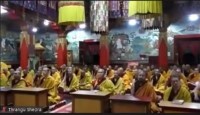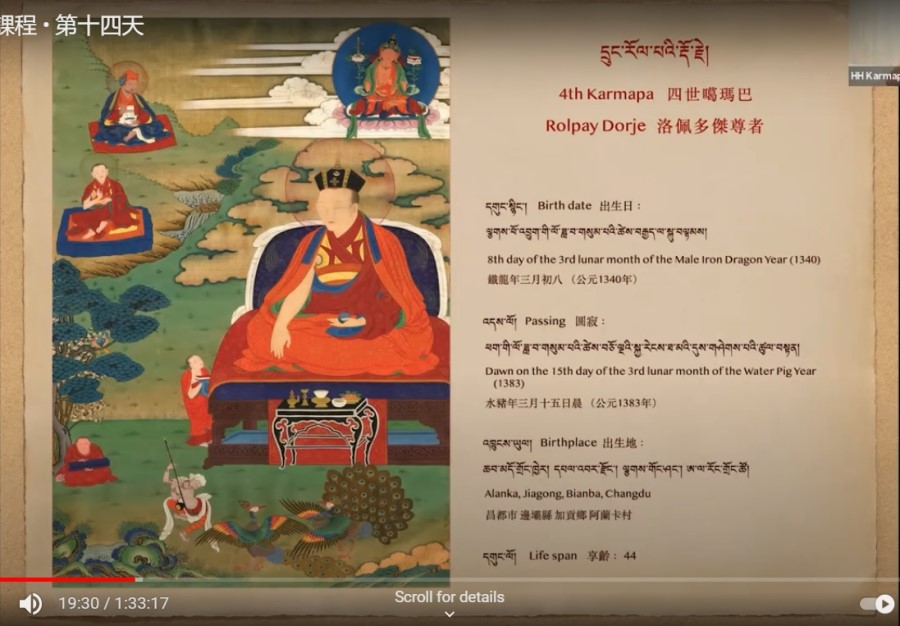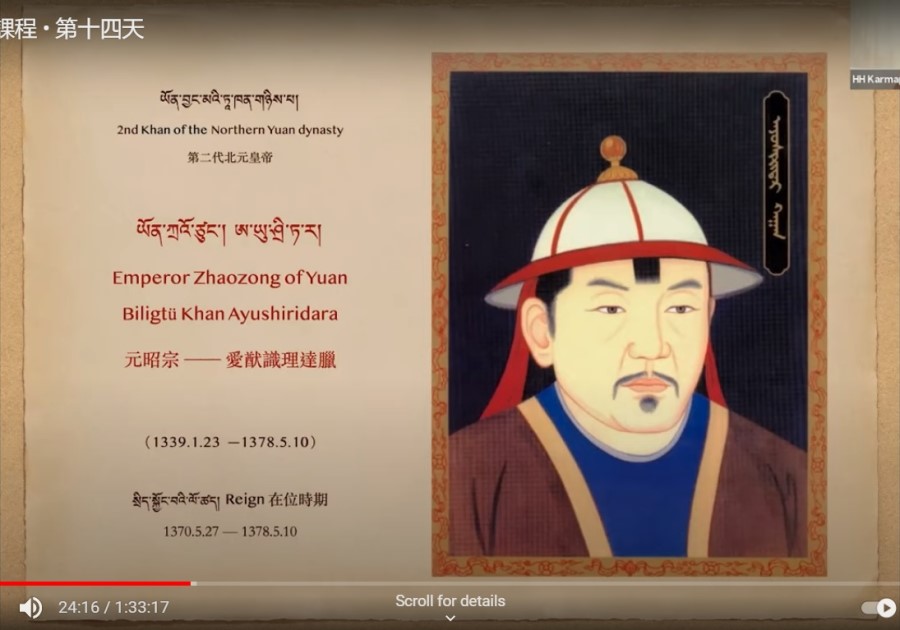法王新闻 | 2021年03月
『第6届谶摩春季』噶玛巴米觉多杰自传•第14天第1堂課
『6th Arya Kshema』AUTOBIOGRAPHICAL VERSES OF KARMAPA MIKYÖ DORJE•14-1
༸རྗེ་བརྒྱད་པ་མི་བསྐྱོད་ཞབས་ཀྱི་རྣམ་ཐར་བཀའ་ཁྲིད། བདེ་བྱེད་མའི་དཔྱིད་ཆོས་ཉིན་བཅུ་བཞི་པ།

开示時間:2021年3月7日晚上9:00-10:00(北京/台北/香港)March 07, 2021
中文口译:堪布丹杰
笔录:释妙竹于2021年9月18日
English text source from: Arya Kshema website
第四世噶玛巴简传和Gandhola佛像的秘密
The Great Encampment during the Life of the 4th Karmapa Rölpai Dorje
法王领唱由他作曲的第八世噶玛巴米觉多杰的《无比自赞》等课前颂。
之后法王开始讲话,但没声音,讲了一两分钟后,现场背景才有人用藏文提醒他,可能是线没接好。
大家听得到吗?说了几分钟,以为大家听得到。总之,再说一次,先问候大家扎西德勒。那么,就像前天谈到的,跟法王米觉多杰传记相关的,有关噶千大营的内容,今天简略讲一下噶千的背景历史,然后在下个星期才会讲得比较详细点。那么,课诵。(法王开始他一贯的课前飞快独诵,向祖师大德们的祈请。)
Following his greeting and offering prayers, His Holiness explained the main topic, giving a brief introduction to the Great Encampment, or Garchen, as it relates to Karmapa Mikyö Dorje’s liberation story. In particular, His Holiness, noted he would focus on the historical and contextual background of the encampment this week and speak about the regulations of the encampment later on.
"嘎千"一词的含义
What do we mean when we say Great Encampment?
当我们说嘎千大营,那么「嘎千」的意思是什么呢?「嘎」的意思就是大营的营,过去西藏会有很多人做迁徙,到了一些地方就会用很多帐篷,像是牦牛帐篷啊、或是布的帐篷结集在一起的,聚居的地方就叫做“嘎”。我们说扎营,就类似这个意思。譬如说象军队的军帐,聚集在一起的地方就是军营。很多商人群聚的地方,商人营帐的地方就是商营。同样,上师还有僧众,有时候为了大众说法,举行法会的时候,就称为法营。譬如说,现在有叫色达的法营、佛法的大营;或者雅千这个地方的法营。但是回到“噶”最原始的一个用意——营的意思上来说,指的就是用牦牛的帐篷、布的帐篷群聚在一起,但是后来演变成很多建筑物聚集在一起,也可以称为“嘎”。但总之,“嘎”最主要的意思是很多个帐篷聚集在一起的一个营区。
His Holiness elaborated on the meaning of the Tibetan word, gar (sgar), referring to sites or camps with many tents. His Holiness clarified that when people would travel from region to region, they would set up and stay in tents made from woven yak hair or fabric. These encampments may be specific to special occasions such as an army encampment, mak gar, a ‘merchant encampment’, tsong gar, and a ‘Dharma encampment’, chös gar. Early on, gar specifically referred to a camp with many tents, and later also meant a group of houses.
再来,“千”是什么意思呢?“千”就是大的意思,就代表说这样的一个营地它的规模、它的人数都是非常大的、非常多的。之后又称为噶玛嘎千,意思就是噶玛巴的大营。这个大营和噶玛巴的关系而得了这样一个名称。过去有一段时间也会称冈仓噶举的父子众,也就是师徒众为「嘎千父子」,法王和法王子叫「嘎千父子」。但这比较是其他派别会这样子来称呼,自己冈仓噶举中不会这么用。过去在藏巴帝思也会有这种「帝巴营」,最主要就是因为藏巴-当时西藏的领袖,和噶玛巴之间有相互的供养和受供的关系,并不是直接有什么关联性。那么嘎千大营、噶玛大营,它和噶玛巴米觉多杰有什么样的直接关系呢?现代的用词来说,「嘎千大营」大概就是米觉多杰办公的公司吧,他的company。那么米觉多杰的头衔是什么呢?就是这个公司的Chairman(董事长)或CEO。那么,「噶玛嘎千」可以说就是噶玛噶举的headquarter(行政总部)。
When we talk about a gar chen, great encampment, we add the extra word, chen or ’great’, and it refers to either the large size of the encampment or that it will well-known. Later this was called the Karme Garchen. The reason for this is the direct relationship between the Great Encampment and the Karmapa. Another term of reference was Garpa Yabse, or the “Master and Disciples of the Encampment,” but this was probably a term from other lineages referring to the Karma Kamtsang. The Karme Garchen in contemporary terms is akin to a company that performed Mikyö Dorje’s work. Mikyö Dorje in this metaphor is like the CEO or company chairman. The Garchen functioned as the headquarters for the Karmapa.
噶玛嘎千和藏传佛教其他的一些行政单位是不太一样的,像「拉章」这样的一个行政单位是不同的,「拉章」一般有翻作“办公室”,「拉章」这样一个私人办公室主要是藏传佛教中比较有地位的这些宗教领袖,像喇嘛的住处;或者说维系他这样一个生活的行政单位,叫「拉章」。比如说,有一个叫喇嘛扎西,他的「拉章」、他的office,就是指喇嘛扎西他个人,或者处理他相关事物的一个地方——办公室。但是嘎千大营虽然和噶玛巴也有直接关系,个人也是有关系,但是它并不是专属噶玛巴的私人办公室,而是更广泛地管理全体噶玛噶举的这样一个单位。所以和一般传统的「拉章」的概念不同。
A labrang refers to a higher lama’s residence or the organization of people who support him. In contrast, the Garchen was directly connected with the Karmapa and functioned as an administration for organizing the Karma Kagyu overall.
Bamboo评论:去年在拉萨,参观了一次罗布林卡,就是达赖喇嘛的夏宫。里面有什么第七世、第十三世、第十四世的一个个“颇章”,应该就是这里说的“拉章”。都是占地广大,走了半天也没绕过一堵围墙的豪华宫殿和园林。Bamboo当时很奇怪,不知道为什么每一世的达赖都要给自己新建一个“拉章”——宫殿,前几世建好的住住,最多扩充、修缮一下不就行了。但看了大宝这里的解释,才终于弄明白,为啥每一世都要花费无数金钱和土地,耗时十数年新建一个宫殿了,因为那是私人办公室,而且各种大小行政事务都是靠一个人拍拍脑子决定的。看起来嘎千大营比较像现代的公司,用规章、制度、以及各个部门的运作来管理噶举派。
「嘎千大营」起源的探究
Establishing When the Garchen Began
那么嘎千大营是什么时候开始的呢?可能没有办法说得太清楚。我们首先问一下,是不是第一世噶玛巴杜松虔巴的时候就有了呢?我想当时应该还没有。因为杜松虔巴就是一个很普通的僧人,他是在后半生的时候才变得比较出名。在那之前,大部分他都是专注在山洞里闭关实修,而且他习惯都是独来独往,不然,最多就是三、五个人吧,他不会带很多人一起走。因为如果他带的侍者、眷属一多的话,就需要准备很多像是马呀、驴子等等交通工具,还有衣食住行,像是帐篷等东西。而在当时,也很难有这么好的条件。至于第二世噶玛巴希和第三世让炯多杰,虽然他们是成为了元、明这两代的帝师,但是他们两位噶玛巴过着的生活还是非常像瑜伽士这样简朴的生活,并没有像大喇嘛、宗教领袖那样子的一种比较铺张的生活。而且第三世让炯多杰比较多居住在“静处”,著作、实修、闭关,他并没有到处的走,还是有去很多地方说法,但是并没有行动的那么多。
His Holiness explained that there are not any clear sources on the origin of the encampment other than Karma Trinelypa’s Questions and Answers: The Brief Meaning of Liberation Stories. If we extrapolate from Karma Trinleypa’s text, it is primarily during the time of the Fourth Karmapa Rölpai Dorje that the encampment became larger in size, its organization became more regulated, and it formally became a true Garchen. For instance, it does not seem likely that the Great Encampment began during the time of the First to Third Karmapas. The First Karmapa, Düsum Khyenpa, was an ordinary monk who did not become well-known until the end of his life; and, early on, he primarily practiced in mountain retreats and traveled with only three or four students. The Second Karmapa, Karma Pakshi, and the Third Karmapa, Rangjung Dorje, both travelled to teach the Mongolian or Yuan emperors. Karma Pakshi lived a very yogic lifestyle; and Rangjung Dorje spent his time writing treatises and doing isolated meditation retreats.
因此我们看一下,「噶玛嘎千」是什么时候有的呢?我们可以从一部文献,《噶玛钦列巴问答录要义》这本书中提到过,说第四世噶玛巴洛佩多杰,「第四世法王呢,他特别重视戒律」,接着又提到说,「第四世法王,在他的管理之下,一手建立起嘎千大营的威望和规模」。从这一段话来推测的话,在第四世噶玛巴之前,大概是有营区的这样一个形式,但是是直到第四世法王瑞佩多杰的时候,整个营区才比较有规模、和有组织,才有「嘎千大营」这样一个规模和组织。而且这部著作文献的作者——噶玛钦列巴,他是第七世法王的弟子,而当时又可以说是嘎千大营的全盛时期吧,所以,由他所说的这样一段描述,我觉得是非常有参考价值的。所以这里我们说,「嘎千大营」这样一个单位是什么时候开始的?依照噶玛钦列巴这个文献著作就很重要了,他里面的形容。
Since Karma Trinleypa wrote about the Fourth Karmapa, Rölpai Dorje, in his Questions and Answers: The Brief Meaning of Liberation Stories, we know that the Fourth Karmapa was very assiduous in his practice of the Vinaya. From this time, the encampment became more organized and more impressive. Moreover, Karma Trinleypa was a student of the Seventh Karmapa when the Garchen was at its peak. His Holiness concluded that we can rely on Karma Trinleypa’s words as a solid basis for understanding the early origins of the Great Encampment.
那么,近代的一个学者叫东嘎·洛桑赤列,他形容道:「范围广大、有较严谨的规模和组织的嘎千大营主要是在第七世噶玛巴的时候建立起」,这部分内容可以参阅一个叫《冈仓法阅明月水晶即可指导》(Bamboo:听堪布丹杰的口音拼写的书名,有错误),这位近代…说的原因呢,一是第七世法王的时候是嘎千大营的全盛时期,除此之外,有关嘎千大营到底是什么时候建立起来的?….(Bamboo:直播卡顿听不清楚)这个文献呢,因为第七世法王的时候是全盛时期,所以他才说,那个时候有了嘎千大营的组织,也不能怪他,因为历史文献非常的稀少。就我自己来说,也就只是看到刚刚上面跟大家说的钦列巴的一段话而已,其他文献当中我也没有看到太多有关嘎千大营的描述。
The modern scholar, Dunkar Lobsang Trinley, says that the actual organized encampment developed during the time of the Seventh Karmapa, Chödrak Gyatso, but His Holiness came to the conclusion that this was because it was during the time of the Seventh Karmapa that the Great Encampment became most significant. His Holiness encouraged us to read more of this history in the The Water Crystal of the Moon.
另外一位学者叫土墩贲厝说,「噶玛嘎千大营是第四世法王洛佩多杰从中国返回西藏的时候,由于很多的具信弟子,舍不得和上师分开,所以他们就一路跟随着,到了楚布寺。抵达楚布寺之后,就在上师的住处旁边搭建起帐篷,尽力地精进修持行善,这就是噶玛巴法营的初建因缘」这位学者这样说。但是我花了满多天,查看了很多噶举的,像历史文献,还有传记当中都没有看到这样的说法,或许还是这位学者他看了其他什么样的古老文献呢?或者什么样的原因推测出这样的一个说法,我并不清楚。
His Holiness guided us through his close research into the origins of the Garchen. According to the great scholar, Thubten Phuntsok, when the Fourth Karmapa returned to Tibet from China, many of the faithful monastics and lay people could not bear to be apart from their guru. For this reason, they followed him to Tsurphu and set up a camp near his residence. They spent their time practicing and striving in accord with their abilities. And, this is, in fact, the origin of the Dharma encampment.
但总之,从刚刚噶玛钦列巴那段话中来说,可以说第四世法王洛佩多杰的时候,嘎千大营是有了比较大的规模和组织,我想可以这样说,确定。但是在第四世法王之前的历代噶玛巴,大概就只有一个营区的雏形吧,一个样子而已。还有一部第四世法王洛佩多杰的传记,他是由楚布的昆邦衮卡洛珠和噶玛衮秋许驽俩人写的传记当中,就有很多对于大营的清楚记载,因为这里第四世法王洛佩多杰和嘎千大营的关系,所以我想应该简单讲一下洛佩多杰,但我不细说他的传记,就讲几个重点。
While His Holiness noted the history may be inconclusive, based on Karma Trinleypa’s text, there was clearly an earlier Great Encampment in formation. Kunpang Kunga Lodrö and Karma Könchok Shönnu’s works also provide clear evidence as both mention encampments during the time of Rölpai Dorje.
第四世噶玛巴简传
Summarizing the Important Points of the 4th Karmapa Rölpai Dorje’s Life

那么第四世洛佩多杰的前世是第三世噶玛巴。第三世噶玛巴是在元朝上都圆寂的,上都当时是元朝旧的都城。所以他当时就在上都对大元国师说:“我的下一世将会诞生在工布地区。”就像是第三世噶玛巴这样的一个预言,所以洛佩多杰他就诞生在工布附近这样一个地方。我给大家看一下这个投影——第四世噶玛巴的介绍。这个投影之前有给大家看过,再复习一下,他出生在昌都市边壩县加贡乡阿阑卡村,现在的地名。
His Birth: Since the histories show how the Great Encampment began with the Fourth Karmapa, His Holiness summarized the key points of Rölpai Dorje’s life. He began with the passing of the Third Karmapa, Rangjung Dorje. Rangjung Dorje passed away in the Mongol emperor’s palace in the Yuan Dynasty capitol, Xanadu. Prior to his death, Rangjung Dorje predicted he would be reborn in the eastern region of Kongpo. This is near Rölpai Dorje’s birthplace in Namdzong in Gochen Pangkar in Ngö, these days known as Alanka, Jiagong, Bianba, and Chengdu.
他的父亲名为索囊敦珠,母亲名为江氏•尊珠柬,诞生在公元1340年,圆寂年份是在1383年,享龄是44岁。他就是在莫•阿阑容这样一个地方诞生,当时是谁认证他为转世呢?由多旦滚波蒋岑认证他为让炯多杰的转世。他的主要上师有三位:嘉华用敦巴、杜丹衮波蒋岑、还有图旦大几瓦,这是他最主要的三位上师。同时他依止了根敦岗巴的大堪布——敦珠巴接受了出家和近圆戒,他出家的法名叫藏羚却给杂巴。我们常在一些经论中会看到“藏羚却给杂巴”,这其实是第四世法王的名字。
Rölpai Dorje’s father was Sönam Döndrup and his mother was Dzomsa Tsöndru. Of the Dong Minyak clan, he was born in the Male Iron Dragon year (1340) on the eighth day of the 3rd month and he passed away at the age of 44. Tokden Gönpo Gyaltsen recognized Rölpai Dorje as Rangjung Dorje’s reincarnation. His main three gurus were Gyalwa Yungtönpa, Tokden Gönpo Gyaltsen, and Tokden Dargyalwa. He took full ordination from Döndrup Pal, the Khenchen from Gendun Gang, and his ordination name was, Dzamling Chökyi Drakpa. When we see the name, Dzamling Chökyi Drakpa, we know this is Rölpai Dorje.
他是一位严持戒律的行者,周围的人围绕的也多是清净的比丘。那么在噶玛衮秋写的传记中提到:法王身边的侍者都是行持三净肉者。他们师徒曾经住过的这个地方,如果看到牲畜被杀了之后的这些骨头什么的留下来的话,都会被骂;酒的味道是完全不会在嘎千大营中闻到的,他的持戒是非常清净的。
Rölpai Dorje, known for his strict adherence to Vinaya, encouraged his attendants to keep pure discipline. His Holiness gave examples of how they all upheld virtuous discipline by eating only the three white foods – milk, sugar, butter, and so forth. Also, if they saw anyone with meat or bones, they would criticize them.
尤其洛佩多杰有一个特点:他能够在梦中自在地变换。他是怎么样转变他的梦境呢?举个例子,譬如说他有很多想要读的经书,但不可能都看完,所以他在睡之前,他会把这些经书全部打开,放在他的床铺旁边,前后左右全部都把书本打开,一本一本放好,接着他就睡觉,睡着之后,他在梦中就变换出很多个他的化身,大概有十五、十六个洛佩多杰变换出来,就在那边读经、看这些经书。接着他醒来之后,这些经书他都读懂了,全都会了。他曾经就自己说过:「我是一个精通于变换梦境的人,因此我和魔术师是没有差别的。那些魔术师的变换和我对于梦境的变换是一样的,对我来讲,转变梦境非常的容易。」
His Lucid Dreams: His Holiness then described Rölpai Dorje’s ability to emanate in his dreams; he had such great power over lucid dreaming. At night, for instance, Rölpai Dorje would leave many texts open around him before he went to sleep and while he slept, he would emanate many bodies. When he woke up, he would know what was said in each of the texts. As Rölpai Dorje stated, “The way I have lucid dreaming, is no different from the way illusionists create different illusions.”
钦列巴大师也说:「第四世法王非常天资聪颖,他不用刻意地做什么学习,他其实都会了,但是他还是非常好学不倦。所以他成为了第八世法王之前在噶玛巴当中,在中观和量论方面的佼佼者。同时,他在诗词的造诣上是无人能出其右的。」钦列巴是这样赞叹第四世法王他的诗词造诣,钦列巴自己在诗词造诣上已经够厉害了,但他还赞叹他。总之,洛佩多杰也带领出非常多殊胜的弟子,像是夏玛卡确汪波等等。(Bamboo批:钦列巴这段话好像在写大宝一样,以前看一篇文章,说是好几个噶举寺庙都会选一些年轻喇嘛和大宝一起听课,那些年轻喇嘛就说大宝听完都没见他有复习,也没见他刻意做什么学习,就都会了,觉得他本来就都会一样。)
According to Karma Trinleypa, Rölpai Dorje had a strong innate knowledge so even though he did not have to study much, he still studied. Among all the Karmapas prior to the Eighth Karmapa, Mikyö Dorje, Rölpai Dorje understood Validity and the Middle Way. He was also a skilled poet. While Karmapa Rangjung Dorje wrote the famous One Hundred Jataka Tales, one of the most beautiful texts, it was Karmapa Rölpai Dorje who wrote the best poetry. He also had many amazing students like Shamar Khachö Wangpo.


之后在火蛇年1356年时候,洛佩多杰就收到元朝第十四代皇帝叫妥恮贴睦尔,还有太子——爱猷识理达腊,俩人的供养和迎请的诏书。接着19岁,1358年他就到了中国,这个就是第十四代的皇帝妥恮贴睦尔。藏文文献中说他是第十四位大汗,中文文献说是第十五位大汗,他也叫做元顺帝。接着就是他的太子。在这两位的迎请之下,在19岁时,1358年的5月,从楚布寺经由北方的路,因为去康区的时候有南、北两条路,他是从北方这条路前往中国。路程当中他也到了祖庭——噶玛寺,还有拉丹寺等等。
Through a series of slides and detailed stories, His Holiness explained one of the main images, the Jowo Gandhola, central to the Karma Kamtsang. The story begins in the Fire Monkey Year (1356) when the 14th emperor of the Yuan Dynasty, the Mongol Toghon Temür (1320-1370, reigned 1333-1370) and his son, the Crown Prince Ayushiridara (1339-1378, reigned 1370-1378), sent great offerings and an invitation to Rölpai Dorje. In the 5th month of 1358, Rölpai Dorje, left Tsurphu at the age of 19 and travelled along the northern route, stopping in Karme and Lhateng monasteries along the way.
Gandhola佛像的秘密
The Jowo Gandhola
在《贤者喜宴》这本书中提到:就在这段时期前后,有五位印度的瑜伽士,就来到法王大营前,他们对法王说:“我们要去中国五台山朝圣。”他们就给了法王一个说是当年龙树菩萨亲自制成的一个由菩提树木做成的佛像,供养给他,说“暂时放在你手中,我们回来之前你不要给任何人。”这个佛像、这个所依就叫做“Gandhola”,据说这五位印度瑜伽士好像是护法的化身,因为后来就再也找不到这五个人。这之后,这个Gandhola佛像就变成法王最主要的一个供养对境,他每天、每座法都会更换供品。我们一般是每天换一次供品,他是每座法都换一次供品,而且日夜四座法他都不断地礼拜、转绕这个特殊的佛像——Gandhola佛像。法王身边的人都受到感动,也都精进行善。
In the Dharma history A Feast for Scholars, it explains that around this time, five yogis came from India and told Rölpai Dorje that they were going to Wutai Mountain in China. They gave him an image carved from the Bodhi tree by Nagarjuna called the Jowo Gandhola. From that time, the Jowo Gandhola image became the primary representation for Rölpai Dorje who made prostrations, offerings, and circumambulated the image four sessions a day. This made a strong impression on his entourage and inspired them to practice virtue.

但是在其他洛佩多杰传记中,到底什么时候他拿到了这个Gandhola这样一个所依圣物,并不是很清楚。这里看一下投影的唐卡。这副唐卡是在八蚌寺的噶举经鬘传承祖师中的一副。这个就是第四世洛佩多杰,你可以看到右下角有一些印度人,有一二三四五,手捧着一个像是正觉大塔的佛塔,就是这个。有这样的传说,就是五个印度的瑜伽士供了这样一个所依圣物。到底这个Gandhola到底是什么?他就是后来成为嘎千大营的主尊的佛像。为什么他叫“见陀拉”(Gandhola)呢?这个名称取自于当时代表佛陀所居住的地方,叫做“见陀具知”,梵文中佛的居室的一部分,变成“见陀拉” (Gandhola)一个佛像。意译来翻的话,“见陀具知”就是指“香室”。所以历代的噶玛巴都会在这样一个圣物——见陀拉(Gandhola)佛像前领受戒律,像沙弥戒、比丘戒等。这里有提到说「持黑帽者——第六尊狮子佛的化身,在至尊“见陀拉” (Gandhola)前剃发,然后领受居士戒。」
His Holiness displayed a slide of a thangka of Rölpai Dorje from the Kagyu lineage thangkas kept at Palpung Monastery. His Holiness directed our attention to the corner of the thangka where he pointed out the five Indian yogis offering the Gandhola. The reason the image is called Gandhola, His Holiness explained, is that in India, temples where the Buddha stayed are called Gandhakuṭi or Gandhālaya. Gandhola is a corruption of those terms. In Tibetan, it would be called “the fragrant temple”. The Gandhola became the primary shrine for the successive Karmapas. When they would take their novice vows or full ordination, they would take their vows in its presence. For example, if we look at the liberation story of the Seventh Karmapa, written by Goshri Paljor, he writes: The supreme support for the meditation of the successive incarnations of the Bearer of the Black Crown, the emanations of the Sixth Buddha Lion’s Roar, is called the Jowo Gandhola. In the presence of the unrivaled image, a clear carving of a thousand buddhas in the amazing material of bodhi wood, a wondrous supreme Gandha temple, the hair of the great being who was our guide was cut.
而且,我想大约就在第七世法王期间,就开始有盛大布置,就在这样一个见陀佛像前,广大陈列供品的传统。应该是第七世法王的时候开始的。至于是怎么样一个布置法、怎么样一个庄严法,我们在下个星期讲嘎千大营的时候再多说一些。很幸运的是,我在几天前,拿到了由夏玛衮秋彦拉所写的一个叫做《嘎千殊胜所依-见陀大佛》的一个目录,当中就解释道:这个“见陀佛”有七个殊胜圆满:因圆满、陈列圆满、作者圆满、来源圆满、能力圆满、事业圆满、加持圆满等等。简略地来说,我就不念了。
Thus, the Seventh Karmapa had his hair cut and took his novice vows in front of this shrine. The tradition of making offerings, large and small, began at the time of the Seventh Karmapa. His Holiness animatedly explained an exciting aspect of his research. He said, “One good thing that happened was that a few days ago I received, A Catalogue of the Gandhola, the Supreme Image of the Great Encampment by Shamar Könchok Yenlak. Here it says, the main sacred object of the encampment has seven excellent qualities: material, image, maker, origin, power, activity, and blessings.” Unfortunately, the pages describing the maker and the origin are missing. The Karmapa detailed these qualities according to the text:
1, “因圆满”是什么呢?它的材质是菩提迦耶的菩提树的木头所制成的;
The excellent material is that is made from wood of the Bodhi Tree in Bodhgaya.
2, “陈列圆满”是因为我们菩提迦耶有正觉大塔嘛,就是他后面还有正觉大塔,当时阿育王建立在菩提树前的,和“见陀拉”陈列布置是相似的,就像正觉大塔有佛像在里面,我们要从外面这样子看过去,这个圣物雕刻的样子是这样子,就像是正觉大塔我们要看佛像时,是从外往里看这种感觉;
The excellent image is the depiction of the Mahabodhi statue and Gandhola temple built around it by Emperor Ashoka, and how the statue can be seen through the door.
3,4,再第三个“作者圆满”跟“来源圆满”部分呢,可能是缺页的关系,在目录中就没有这两个部分的记录,可能以后找到再跟各位讲。
The third excellence is the maker.The fourth excellence is the origin.Unfortunately, the pages describing the maker and the origin are missing.5, 第五个是“能力圆满”,就是这尊佛像无论在哪里,那个地方就不会有地震、雷电、水灾、火灾,还有毒药、战争、疾病等等都会平息,而且未来也不会再发生,它的能力是圆满;
The excellent power is that wherever this image was brought, the ground would tremble, lightning would flash, and all fires, floods, poisons, weapons, illness, hunger, conflict and so forth would be pacified and not occur.
6, 第六个是“事业圆满”,据说是因为诸佛事业的化身——噶玛巴呢,他也会向这个所依礼拜和供养,因此他受到了中国西藏、蒙古各地的迎请,然后利益广大的众生。
The excellent activity is that since the Karmapa, embodiment of the activity of all buddhas prostrated and made offerings to it, it was brought to many locations in India, Tibet, and Mongolia benefiting beings.
7,第七个是“加持圆满”,就像是《大般若经》当中说:投身在菩提迦耶金刚座周围的众生,除了异熟业之外,他们不会受到任何伤害。因为这尊佛像是由印度的菩提树所制成,它也具有和圣地菩提迦耶一样的加持。再来,比起观修其他坛城的本尊,如果将这尊佛像观为对身和意的所依而祈请的话,将能快速得到加持,过去的祖师是这样子说的,所以这里说“加持圆满”就这意思。这个目录中提到有这么几种圆满。
The excellent blessings are that, just as it is said in the Prajnaparamita sutras, beings who enter the area around the Vajra Seat will not be harmed except as a full ripening of karma. Since this image was made of wood from the Bodhi Tree, it had the same blessings as the sacred place of Bodhgaya. Also doing front and self-visualizations in the presence of this image had stronger and faster blessings than meditating on other yidam deities.
但是这样一个“见陀佛像”的圣物现在在哪里呢?好像都从来没人再说过、听过它了、不知道它了。其实这尊佛像在第十世法王时期,当时蒙古固始汗侵略,毁灭了整个嘎千大营。所以在那之后,就再也没人听说这个佛像的消息了。第十六世法王的私人秘书,当时法王还在西藏的时候,叫仁谦巴桑这个秘书,他撰写了一个楚布目录中提到:这个佛像被西藏政府没收了。但是我也问了十六世法王身边的一些人“见陀拉大佛怎么样了?下落如何?”但是没人说得清楚,都没人知道。
However, the Gandhola seems to disappear from the records after the time of the 10th Karmapa, when Mongol Güshi Khan destroyed the Great Encampment. However, Rinchen Palsang, private secretary to the 16th Karmapa, recorded that the regional Tibetan government took it while the 16th Karmapa was in Tibet.

但是有一个有趣的地方,就是在70年代,有两位外国人,叫尼克• 道格拉,还有marry• white,这两个人写了一本书,就在70年代用英文写了一本书,书名叫《KARMAPA: THE BLACK HAT LAMA OF TIBET》,就是噶玛巴是西藏的黑帽上师,这是这本书的投影。它是在1976年英国出版的这本书。这本书中写道什么呢?提到他们当时到了锡金,有见到十六世法王,还有法王子,而且还有合照等等,也做了访问。
His Holiness noted, however, that the 1976 publication by Nik Douglas and Meryl White, entitled, Karmapa:The Black Hat Lama of Tibet, includes pictures of some of the sacred objects that the 16th Karmapa brought with him when he fled Tibet. This book includes interviews with the 16th Karmapa and his heart sons in Sikkim as well as an image of the Buddha made by Nagarjuna.
同时呢,他们还拍摄记录了一些十六世法王从西藏带出来的珍贵法物,有这些照片,其中有一张照片就提到说“是由龙树菩萨亲手制成的一个佛像,后面雕刻有佛陀的各种事业”等等,就是这尊,就是这个照片。所以你看在英文里面有提到说,这是释迦牟尼佛像,里面形容,后面有佛陀的十二相成道,同时也说,这尊佛像当时有五个印度人送给第四世法王的。就是在这些印度人要去中国的时候,供养给第四世法王的,谁做的呢?这尊佛像是龙树菩萨他亲手做的。
Below the image, the text states:The statue of Lord Buddha, showing miraculous events of his life. This is one of two which were presented to Karmapa Rolpai Dorje by five Indian Holy Men, whom he met on the way to China. This statue was made by Siddha Nagarjuna, out of a metal-like material which was recovered from the magical lake of the serpent kind (Nagas). It is preserved at the new Rumtek monastery, Sikkim.
当我一看到这尊佛像,我看了好多次,然后再看到过去的历史文献的时候,我想“见陀拉”(Gandhola)大概就是这个。所谓的Gandhola佛像就是这尊!我是这样子想的,但是当我去翻阅像是后面记着楚布圣物的这些目录,还有很多我们噶举的历史传说,都没有说这尊像就是Gandhola这个佛像。我就在想“为什么没有写清楚是这个呢?”我想,大概就是因为怕太出名,而且又这么重要,是嘎千的主尊所依。在旧社会那个时候,如果你太出名的话,就会被西藏政府没收去了。所以,就刻意地保持低调,在什么记录里都不提。总之,这里面没有特别提“这就是Gandhola”——嘎千大营的主尊所依,只提到说是龙树菩萨所造作的一尊佛像而已。日后希望有熟悉这部分历史的人可以跟你请教一些,但我想就是这个,你看它后面有香室的这样一个,佛陀他住的地方叫点香的香室这样一个雕刻在背后。而且你看到这一尊的样子也有点像我们从正觉大塔要看进的大佛那个样子。就像你要从大塔外看里面的佛像,你就会看不到上面大塔的塔尖,就是看到大概是这个样子。但是如果有熟悉这尊佛像的人,这些喇嘛们如果你们知道的话,可以再多分享一些,相关的内容。
His Holiness noted that he thinks this image must be the Gandhola, but even in the catalogues and oral histories from Tsurphu Monastery, there is no mention of this being the Gandhola at all. Maybe there is a story behind this, His Holiness explained, because as the main sacred object of the Great Encampment, they were worried someone might seize it. For this reason, they downplayed it and did not use the name Gandhola. His Holiness hopes that if anyone knows more history, they can offer some explanation.
Bamboo评论:这尊像带着个书生一样的帽子,头还低低的让人看不清相貌。Bamboo琢磨着应该是龙树按照自己的相貌雕刻的吧。那个著名的台湾慈济的胜严法师不是做了一个”宇宙大觉者“的像,到处送人让信众参拜,像的面貌就是她自己的样子。神通无敌,让后人无比敬仰的龙树菩萨竟然也降伏不了自己的我慢和心魔啊。
第四世噶玛巴的一些神迹
Rölpai Dorje Spreads the Dharma during his Travels
回到第四世洛佩多杰,他又回到了令界一些地方。那么他在玛曲的零库,在玛曲三个水流漩涡的其中一个地方,大概就是现在安多地区那里。他就在一个石头堆叠而起的法座上说了很多法。当时是夏天,洛佩多杰说法的那个石头旁,在夏天的时候就长出了一个前所未见的植物,它有一个根,但是有八个茎,每一茎上又开出了一百多花,每朵花又有一千个黄色花瓣,每朵花的红芯花心上又都有黄色花蕊等等。每个人看到这个花,听到这个事的人都很惊讶。当时有个叫郭挼敦巴的善知识,他就想说这朵花太特别,如果更多人看到的话,会有利益。当时当然没有照相机,他大概就把它复印了那个花呢?是把那个花染色印在一张纸上呢,还是怎么样,总之,他就复制了这个花的样子,送给了很多人。所有看到这个花的人都升起了信心,有这样一段故事。
After this, Rölpai Dorje continued travelling east. He came to a place called Machuy Ling, in present day Amdo region. There, Rölpai Dorje taught the Dharma. The following summer, at the base of the throne where he had taught, a flower grew. This flower had never been seen previously. It had one stalk and eight branches. Each branch had eight flowers with a red corona and yellow center. It was a really strange flower. Anyone who saw or heard of it thought it was really strange. At this time, one monk, Geshe Kyuru Tönpa, said this flower was really amazing. Thinking that this flower would help people develop faith, he either drew an image or took a pressing. He distributed these widely throughout the region and anyone who saw the picture was said to have developed faith.
之后,他又到了汉藏两地的一个边界,大概就是甘肃的地方,当时元朝的皇帝派了很多使者去迎请他,但是当时中国是很动荡的,所以他没有去。他继续前往西夏的地方,就是现在康定的地方,当时西夏这个地方因为一直在战争,大概有长达25年的战争,他都将这些战争平息、调和了。
When Rölpai Dorje went to the border area between China and Tibet, even though there were unresolved conflicts, he resolved all the disputes and everyone promised not to fight for twenty-five years.
之后皇帝又再次请他前往中国,他想:如果再不遵旨的话,可能带给寺院和这个地方很多的一些灾难。所以他就遵循皇帝所说的,为了利益佛法,他就受邀了这个邀请。他到了灵瑶这个地方呢,由八思巴尊者所建的一个寺院,那里面有一个堪布巴丹,在兰州这个地方有四个寺院,有一个叫白塔寺,第四世法王到了这个地方,之后又到了西夏地方。因为要对不同民族的人说法,…蒙古文的翻译,然后在左方放了汉语的翻译,洛佩多杰讲法的时候,这些翻译即席地翻译。法王的开示也利益了非常多的人。
The Emperor had sent a message expressing distress if Rölpai Dorje were not to come to see him. So, the Karmapa went to Lintao monastery founded by Drogön Chögyal Pakpa where he met Khenpo Palden of Lintao. The Mongol Emperor had also invited Sakya Pandita who built Trulpay De. Rölpai Dorje also went to Minyak where he taught the Dharma to many people of different nationalities through Mongol, Uighur, and Chinese translators.
有一次他在路程当中就染病了,当时很多人就说:该怎么办?他就说:“没问题,我来做个梦,来治这个病的话,就可以了。”他的侍者叫做库伊昆巴,他就跟这个侍者说:“你就让我睡,别吵我。”还记得吗?他在梦中很厉害,能够各种变换,所以就算是感冒,他也不用吃什么药,总之睡完之后,一醒来,这个病就好了。他的这些侍者,像库伊昆巴等就问他说:“你晚上发生什么事?你是怎么弄的?”法王就说:我梦中去了布达拉宫——就普陀珞珈,普陀山,然后有一个红色的观音菩萨,手持一个甘露瓶,她就把那个甘露瓶给了我,叫我把里面的甘露喝掉,我就喝了。喝了之后,我就升起了这样一个乐明无念的觉受,病也就好了。”这也是说他在梦中能够自在变换的一个例子。
While he was traveling, he caught a cold. He told his attendant, Guogong Rinchen Pal, that he would cure his illness through a lucid dream and instructed him not to wake him. Later, when he awoke, he explained how he was completely cured: In my dream, I went to the Potala palace where I saw red Chenrezig who was holding a vase of amrita nectar. He gave that to me and after I drank it, I had this experience of bliss, clarity and non-thought, and my cold was cured.
Bamboo评论:为啥Bamboo总睡得跟头猪一样呢?
先讲到这里,休息一下。
Youtube 视频
